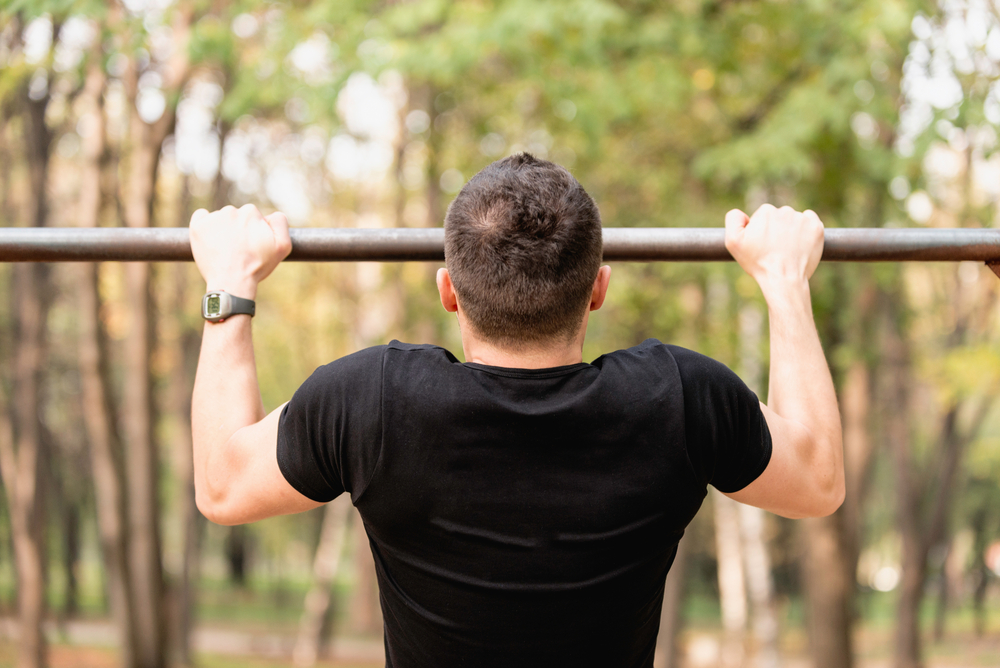Pull-ups are known for being a highly effective back-building exercise.
They also bring your shoulders into play as well as your core muscles.
There are gym-goers out though that seem to feel some effects of pull-ups in their chest.
That’s what we’re looking at in this article – do pull-ups actually work your chest too or could there be another reason why people feel pull-ups in their chest?

Do Pull-Ups Work Chest?
In basic terms, your chest is somewhat involved in the pull-up movement.
That being said, it isn’t one of the primary muscles being worked and pull-ups alone won’t be enough to build your chest.
Pull-ups are primarily focused on your back (mainly the lats) and shoulders.
Your chest plays a small role in the exercise but it would be inaccurate to say that pull-ups are good for your chest.
Why Do Some People Feel Chest Pain During Pull-Ups?
As your chest isn’t one of the primary muscle groups being targeted by pull-ups, any pain felt during the movement could be an indication that something’s wrong.
The first thing to consider is that your technique could be incorrect.
Pull-ups are quite a complex exercise so you need to ensure you get the technique exactly right.
Even small errors can lead to other muscles coming into play (like your chest) which can cause pain and discomfort in areas you shouldn’t be feeling it.
That being said, very mild discomfort in your chest during pull-ups could indicate that you’re doing things correctly.
As your chest is a secondary stabilizing muscle during pull-ups, some very mild discomfort may be felt. Anything more than this though might be something less positive.
Another potential reason why some people feel chest pain during pull-ups is that they’re carrying a chest injury.
A strained chest muscle or similar could be aggravated by pull-ups which can cause pain.
Why Do Some People Feel Chest Pain After Pull-Ups?
Feeling pain in your chest after pull-ups could happen for a number of reasons.
The first is that your chest has been placed under stress during the exercise so the muscles are repairing themselves.
This could be perfectly normal after pull-ups, although severe pain should never be felt in your chest after pull-ups as the chest muscles are only secondary muscles and are not primarily targeted in the exercise.
You may also have injured your chest during pull-ups which results in pain being felt afterward.
Anything more than mild discomfort in your muscles after any exercise should be monitored and medical assistance sought if it gets too bad.
Can Pull-Ups Reduce Chest Fat?
There seems to be an incorrect assumption that many people have that you can pinpoint specific areas of your body where you want to lose fat from.
This isn’t the case unfortunately, and while you can target specific muscles during exercise, burning fat is done with your whole body as the target area.
Pull-ups can be used as part of a fat-burning program. This program could result in chest fat being reduced.
However, you won’t be able to specifically target chest fat with pull-ups (or any other exercise).
Instead, body fat is burned from anywhere it’s located in your body.
You can’t isolate one particular area of fat to work on like you can with muscle-building programs.
Pull-ups can reduce chest fat but only as part of a fat-burning program. They won’t specifically target fat in that one particular area.
Which Muscles Are Pull-Ups Good For?
Primarily your back and shoulders will benefit from pull-ups.
They aren’t the only muscles involved in the exercise though as pull-ups are a compound exercise.
This means that multiple joints and muscles are activated and worked during the movement.
Muscles worked during pull-ups include
- Latissimus Dorsi (Lats)
- Teres Major (back)
- Biceps (arms)
- Trapezius (Traps)
- Deltoids (shoulders)
- Pectorals (chest)
- Core Muscles (trunk of the body)
All of the muscles involved are worked to varying degrees with some seeing more benefits than others.
That being said, all of the muscles involved play a role in pull-ups so will all be placed under stress at different points of the movement.
Conclusion
In summary:
- Pull-ups aren’t a great exercise for building your chest.
- Pull-ups mainly work your biceps and back muscles.
That’s all for this article, but how many pull-ups should a 13 year old do? Or perhaps you’re wondering why is it so hard to do pull-ups?
Hope this helped!
Sources
I’ve been in the fitness and strength training industry for nearly a decade. In that time, I’ve gained 30 pounds of muscle, written hundreds of articles, and reviewed dozens of fitness supplements. As for my educational background, I’m a currently studying for my Active IQ Level 3 Diploma in Personal Training.

